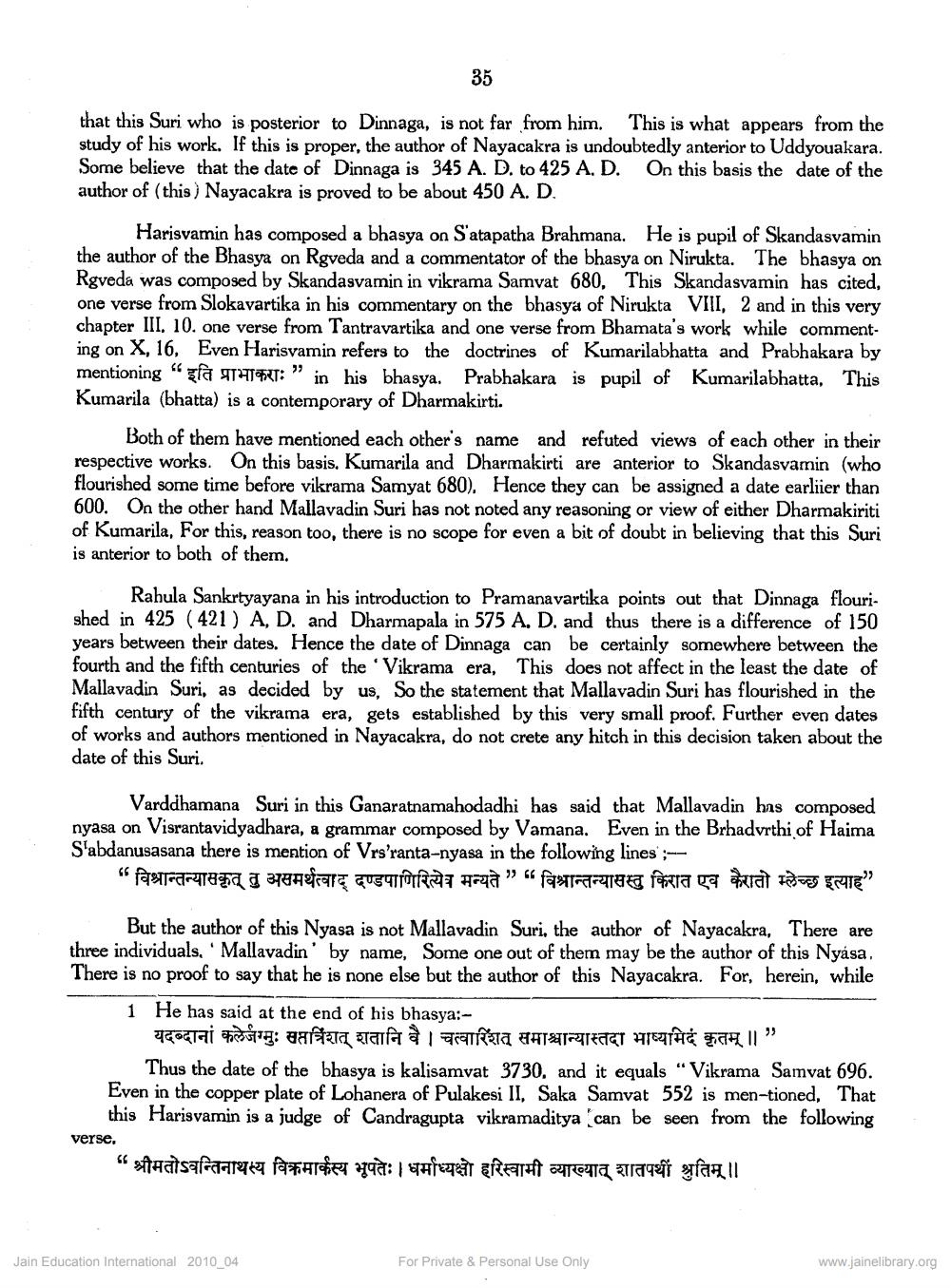________________
35
that this Suri who is posterior to Dinnaga, is not far from him. This is what appears from the study of his work. If this is proper, the author of Nayacakra is undoubtedly anterior to Uddyouakara. Some believe that the date of Dinnaga is 345 A. D. to 425 A. D. On this basis the date of the author of (this) Nayacakra is proved to be about 450 A. D.
Harisvamin has composed a bhasya on S'atapatha Brahmana. He is pupil of Skandasvamin the author of the Bhasya on Rgveda and a commentator of the bhasya on Nirukta. The bhasya on Rgveda was composed by Skandasvamin in vikrama Samvat 680, This Skandasvamin has cited, one verse from Slokavartika in his commentary on the bhasya of Nirukta VIII, 2 and in this very chapter III. 10. one verse from Tantravartika and one verse from Bhamata's work while commenting on X, 16. Even Harisvamin refers to the doctrines of Kumarilabhatta and Prabhakara by mentioning "gla TVRT:" in his bhasya. Prabhakara is pupil of Kumarilabhatta. This Kumarila (bhatta) is a contemporary of Dharmakirti.
Both of them have mentioned each other's name and refuted views of each other in their respective works. On this basis. Kumarila and Dharmakirti are anterior to Skandasvamin (who flourished some time before vikrama Samyat 680). Hence they can be assigned a date earliier than 600. On the other hand Mallavadin Suri has not noted any reasoning or view of either Dharmakiriti of Kumarila, For this, reason too, there is no scope for even a bit of doubt in believing that this Suri is anterior to both of them.
Rahula Sankrtyayana in his introduction to Pramanavartika points out that Dinnaga flourished in 425 (421) A, D. and Dharmapala in 575 A, D. and thus there is a difference of 150 years between their dates. Hence the date of Dinnaga can be certainly somewhere between the fourth and the fifth centuries of the 'Vikrama era, This does not affect in the least the date of Mallavadin Suri, as decided by us, So the statement that Mallavadin Suri has flourished in the fifth century of the vikrama era, gets established by this very small proof. Further even dates of works and authors mentioned in Nayacakra, do not crete any hitch in this decision taken about the date of this Suri.
Varddhamana Suri in this Ganaratnamahodadhi has said that Mallavadin has composed nyasa on Visrantavidyadhara, a grammar composed by Vamana. Even in the Brhadvrthi of Haima S'abdanusasana there is mention of Vrs’ranta-nyasa in the following lines':--
"विश्रान्तन्यासकृत् तु असमर्थत्वाद दण्डपाणिरित्येव मन्यते" "विश्रान्तन्यासस्तु किरात एव कैरातो म्लेच्छ इत्याह"
But the author of this Nyasa is not Mallavadin Suri, the author of Nayacakra, There are three individuals, Mallavadin' by name, Some one out of them may be the author of this Nyása. There is no proof to say that he is none else but the author of this Nayacakra. For, herein, while
1 He has said at the end of his bhasya:
यदब्दानां कलेजग्मुः सप्तत्रिंशत् शतानि वै। चत्वारिंशत् समाश्चान्यास्तदा भाष्यमिदं कृतम् ॥”
Thus the date of the bhasya is kalisamvat 3730, and it equals “Vikrama Samvat 696. Even in the copper plate of Lohanera of Pulakesi II, Saka Samvat 552 is men-tioned. That
this Harisvamin is a judge of Candragupta vikramaditya can be seen from the following verse.
" श्रीमतोऽवन्तिनाथस्य विक्रमार्कस्य भूपतेः। धर्माध्यक्षो हरिस्वामी व्याख्यात् शातपथीं श्रुतिम् ॥
Jain Education International 2010_04
For Private & Personal Use Only
www.jainelibrary.org




